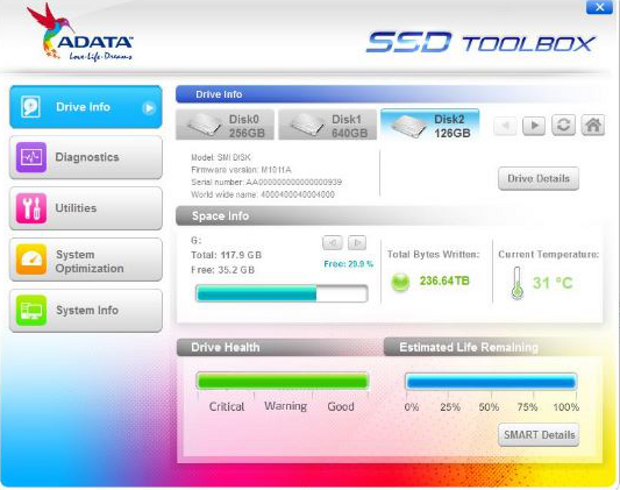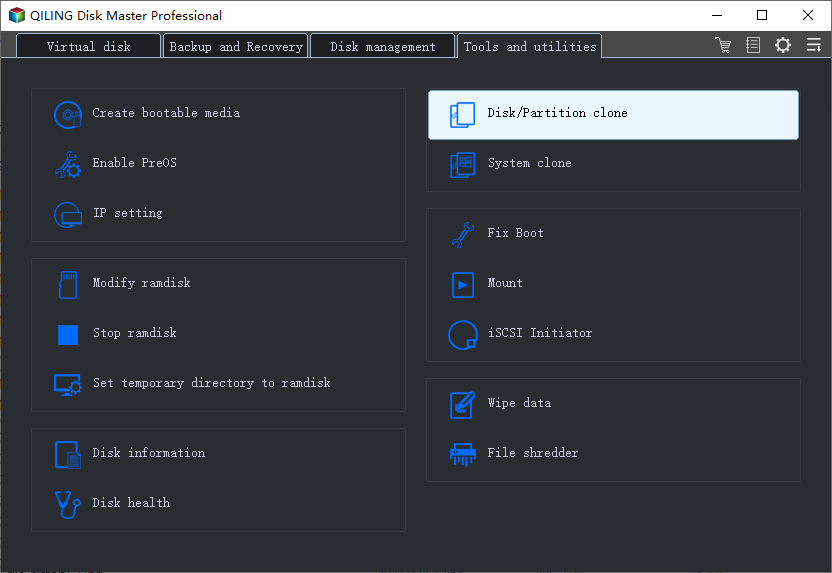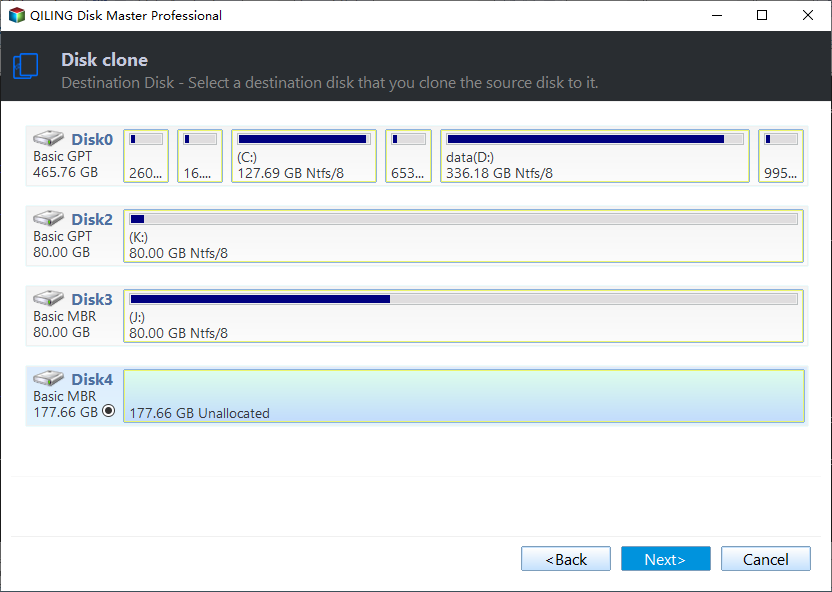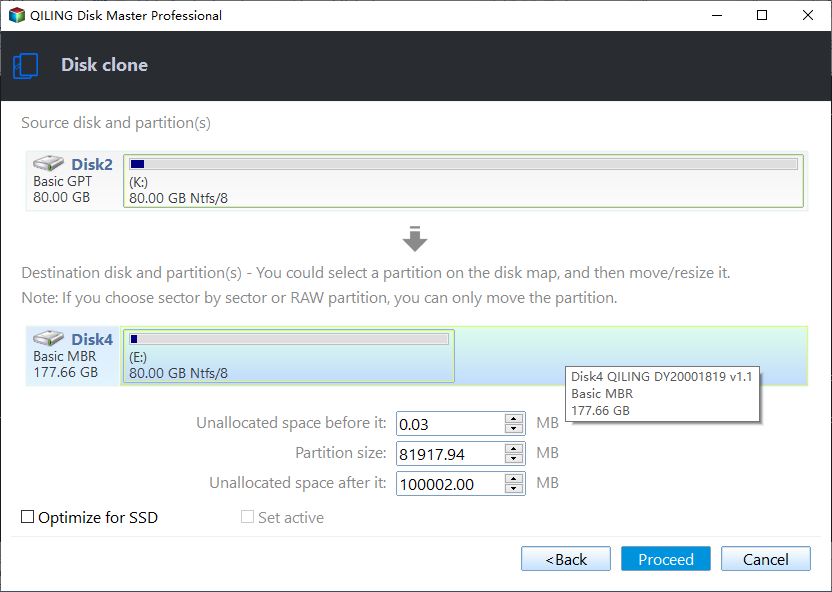Best Free ADATA SSD Clone Software - Qiling Disk Master
The Case: Problem to Clone ADATA SSD
"OK, I have a 120GB ADATA SSD with My Windows 10 x64 computer, and getting the 120GB SSD cloned to larger 512GB SSD using Acronis True Image HD, and wonder why I ca't get the cloned SSD boot up? Or is there any other better way to clone the ADATA SSD and make it bootable, need help please!"
When cloning a smaller SSD to a larger one using Acronis True Image HD, you may encounter issues that need to be resolved to make the cloned drive bootable. Fortunately, there is a reliable ADATA SSD clone software that can help you get through this process smoothly.
ADATA SSD Toolbox and Migration Utility
ADATA provides a toolbox and data migration software for its SSDs, including the Ultimate, XPG, S, and Premier series, to help users obtain disk information, change settings, and speed up their SSDs and extend their lifespan. The company recommends using Acronis True Image HD software to migrate data from a computer's internal HDD or SSD to an ADATA SSD.
Acronis True Image HD is the OEM version of Acronis True Image for certain brands, including ADATA, Crucial, Kingston, Micron, PNY, Seagate, and Western Digital (WD), with limited features such as full disk imaging, active disk cloning, and disk management, and is compatible with Windows XP, Vista, 7, 8, 8.1, and 10. However, it has some limitations that users should be aware of.
- You have to upgrade to Acronis True Image with at least $49.99 extra cost if you want more features.
- Many users complained about the cloned SSD wo't boot after clone with the OEM data migration software.
- You ca't create file and folder backup, incremental backups, schedule backup, etc.
The Best Free ADATA SSD Clone Software
The ADATA cloning software, Qiling Disk Master Standard, is a professional yet free solution that offers comprehensive features to clone HDD/SSD to ADATA SSD or clone ADATA SSD to another one. It provides options for full disk clone, sector by sector clone, and intelligence sector clone, ensuring the cloned SSD is bootable after cloning. Additionally, it offers an SSD alignment option to accelerate the reading and writing speed of the destination SSD.
In addition to schedule settings, Acronis True Image HD also supports file and folder backup, incremental backup, faster backup and recovery, and other features for free, making up for its shortcomings.
As the all-in-one ADATA SSD migration software, it is capable of:
- Cloning ADATA SSD to another ADATA SSD or other brands' drive directly.
- Helping you to clone ADATA SSD to smaller one or larger one.
- Cloning HDD to SSD easily without reinstalling everything.
With professional disk clone features, upgrading from a hard drive (HDD) or solid state drive (SSD) to an ADATA SSD is a breeze, even for those without technical expertise. Using a reliable SSD cloning software, the process is simplified to just a few clicks, making it easy to transfer data and clone the existing drive to the new ADATA SSD.
Before You Get Started
Take the following things ready:
- The larger ADATA SSD.
- Windows computer installed the smaller SSD or HDD.
- Screwdrivers to replace HDD/SSD to another one.
- Download Qiling Disk Master Standard on your Windows computer.
- SATA-to-USB adapter to connect with ADATA SSD if the laptop only one drive bay.
To connect your ADATA SSD to your computer, first, ensure you have a desktop or laptop with a SATA port. If you have a desktop, connect the SSD to the computer using a SATA cable and power cable. If you have a laptop, you'll need a SATA-to-USB adapter to connect the SSD. Once connected, ensure all storage devices are properly connected and can be detected by Windows. This will allow you to access and utilize the SSD's storage capacity.
Safe Clone SSD to Larger SSD with ADATA Migration Utility
Then refer to the detailed steps to clone HDD/SSD to larger ADATA SSD easily and safely:
Step 1. Perform ADATA SSD clone software - Qiling Disk Master Standard after installing. Click Tools and utilities -> Disk Clone.
◉Tips:
✍If you only need to transfer Windows 10 OS to SSD instead of the whole hard drive, you can choose System Clone, which is supported by Qiling Disk Master Professional.
✍The disk cloning process will clone all the partitions on source disk, including system partition, system reserved partition, recovery partition, EFI system partition if exists, data partitions, and all files.
Step 2. Select the smaller HDD/SSD (here is smaller ADATA SSD) as source disk, and click Next >>.
Step 3. Choose the larger ADATA SSD as the destination disk to save files from source disk, and click Next >> to continue.
◉Tip: the destination ADATA SSD will be deleted or overwrite during the cloning process, please backup crucial data in advance. Click OK to go on.
Step 4. Tick SSD Alignment to speed up the larger ADATA SSD.
Step 5. Press Proceed to clone HDD/SSD to ADATA SSD safely after confirmation.
◉Tips:
✍ The Sector by sector clone option allows you to clone all sectors on the source disk, including unused ones, to the destination disk, which should be as large as or larger than the source disk. This option should not be selected when cloning a larger HDD to a smaller SSD.
✍ Edit Partitions: The feature allows for efficient cloning of a small disk to a larger disk, utilizing the full storage capacity of the destination disk. This capability is accessible in the Qiling Disk Master Professional or other advanced editions.
The cloning process takes around 30 minutes or more, depending on the data capacity of your source disk. Once completed, the cloned ADATA SSD is bootable. To finalize, simply change the boot order to boot from the cloned SSD, or replace the original smaller HDD/SSD with the larger ADATA SSD using a screwdriver, and then boot from the cloned SSD drive. That's the only step required.
Conclusion
You can easily clone your HDD/SSD to a larger ADATA SSD with just a few clicks using the free ADATA SSD clone software, Qiling Disk Master. This software is compatible with various Windows versions, including Windows 10, Windows 8/8.1, Windows 7, Vista, and XP, making it a great tool to achieve ADATA SSD cloning safely and efficiently.
For those running Windows Server 2003, 2008, 2012, 2016, 2019 (including R2), Qiling Disk Master Server is a worthwhile option that offers advanced features such as real-time file sync, cloning disks between MBR and GPT disks, differential backups with scheduled tasks, and dynamic disk/volume backup, restore, and clone capabilities.
Related Articles
- ADATA SSD Disk Migration Tool for Windows 10/8/7
- Download the Best Intel SSD Clone Tool for Windows 7/8/10
- Top Two Ways to Clone Samsung SSD to another SSD without Reinstalling
- Create SSD Backup Image with Qiling Disk Master




